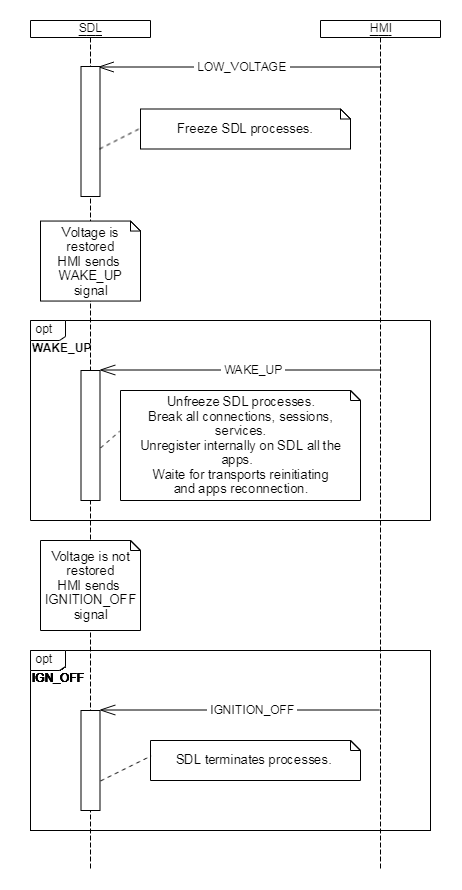Low Voltage
- Type
- Signal
- Sender
- HMI
- Purpose
- To suspend/restore SDL's services due to a low voltage event
Description
A 'LowVoltage' event occurs on HMI when battery voltage hits below a certain predefined threshold set by the system.
In case of such event, SDL operations are halted including receiving and processing of normal RPC messages from HMI.
HMI sends system signals of the range SIGRTMIN - SIGRTMAX for LowVoltage, WakeUp and IgnitionOff to all smartDeviceLinkCore processes.
Must
- Send
LOW_VOLTAGEsignal to SDL when a 'LowVoltage' event occurs - Send
WAKE_UPsignal to SDL when the voltage recovers - Send
IGNITION_OFFsignal when SDL processes have to be terminated, applications have to be unregistered due SDL functionality suspension during a LOW VOLTAGE event
SDL behavior in case of a LOW_VOLTAGE event:
- SDL ignores all the requests from mobile applications without providing any kind of response.
- SDL ignores all responses and messages from HMI except for
WAKE_UPorIGNITION_OFFsignals. - SDL stops audio/video streaming services.
- All transports are unavailable for SDL.
- SDL persists resumption related data stored before receiving a
LOW_VOLTAGEsignal. - SDL and the PoliciesManager must persist 'consumer data' (resumption-related + local PT).
After the voltage level is restored HMI sends WAKE_UP signal to SDL and SDL processes its regular work and all operations resumption.
SDL behavior after receiving a "WAKE_UP" signal:
- After receiving a
WAKE_UPsignal, all applications will be unregistered and the device disconnected. - If
LOW_VOLTAGEwas received at the moment of writing to policies database, SDL and Policies Manager must keep policies database correct and working. AfterWAKE_UPpolicy database reflects the last known correct state. - SDL must be able to start up correctly in the next ignition cycle after it was powered off in low voltage state.
Details of implementation
UNIX signals are used to exchange shutdown and wake-up signals between HMI and SDL Core during a 'LowVoltage' event.
UNIX signals provide ability to use signals from SIGRTMIN to SIGRTMAX for custom needs.
SDL uses this range for handling LOW_VOLTAGE, WAKE_UP, IGNITION_OFF notifications.
Offset for SIGRTMIN from this notifications is defined in the 'Main' section of the smartDeviceLink.ini file:
[MAIN] LowVoltageSignal = 1 ; Offset for from SIGRTMIN WakeUpSignal = 2 ; Offset for from SIGRTMIN IgnitionOffSignal = 3 ; Offset for from SIGRTMIN
Sequence Diagrams
 View on GitHub.com
View on GitHub.com